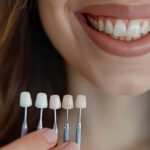When it comes to achieving a flawless, radiant smile, veneers are one of the most popular cosmetic dentistry options. Among the different types available, E-Max veneers and traditional porcelain veneers stand out as top choices. For individuals considering dental veneers in Dubai, understanding the differences between these two materials is crucial to making an informed decision. Both options deliver stunning results, but they vary in durability, appearance, and suitability depending on a patient’s specific dental needs.
What Are E-Max Veneers:
E-Max veneers are made from lithium disilicate, a type of glass ceramic known for its superior strength and translucency. They are crafted to mimic natural teeth closely, making them a preferred choice for patients seeking both beauty and durability. E-Max veneers are also thinner than traditional porcelain veneers, meaning less enamel removal is required during preparation.
What Are Porcelain Veneers:
Porcelain veneers are crafted from high-quality ceramic and have been used in cosmetic dentistry for decades. They are designed to correct imperfections such as discoloration, gaps, and minor misalignments. Although they are slightly thicker than E-Max veneers, porcelain veneers provide excellent stain resistance and deliver reliable, long-lasting results when properly maintained.
Key Differences Between E-Max and Porcelain Veneers:
While both options improve smiles, they differ in key aspects:
-
Material Composition: E-Max is lithium disilicate; porcelain uses conventional ceramic.
-
Strength: E-Max veneers are stronger and more resistant to fractures.
-
Thickness: E-Max is ultra-thin, requiring less enamel removal.
-
Translucency: E-Max offers a more natural, lifelike appearance.
-
Longevity: Both last years, but E-Max may have a longer lifespan with proper care.
Aesthetic Appeal Comparison:
When it comes to aesthetics, E-Max veneers often take the lead due to their translucency and ability to blend seamlessly with natural teeth. They are ideal for patients who want a highly natural smile. Porcelain veneers, while slightly less translucent, still deliver a brilliant white finish, which can appeal to those desiring a brighter, more noticeable smile.
Durability and Strength:
Durability is an essential factor for patients investing in veneers. E-Max veneers are renowned for their resistance to chipping and fractures, making them ideal for patients with active lifestyles. Porcelain veneers are durable but may be more prone to damage if subjected to excessive force, such as teeth grinding or biting hard objects.
Preparation and Procedure:
The preparation for each veneer type varies slightly:
-
E-Max Veneers: Require minimal enamel removal due to their thinness.
-
Porcelain Veneers: Require slightly more enamel reduction to fit securely.
Because E-Max veneers are thinner, patients often find the procedure less invasive and more comfortable.
Cost Considerations:
Cost plays an important role in decision-making.
-
E-Max Veneers: Typically more expensive due to advanced technology and materials.
-
Porcelain Veneers: More affordable but still considered a premium cosmetic option.
Patients should weigh the long-term benefits, as investing in E-Max veneers may reduce the likelihood of replacement or repair.
Suitability for Different Patients:
Each type of veneer caters to specific patient needs:
-
E-Max Veneers: Best for those seeking natural results, minimal enamel reduction, and superior strength.
-
Porcelain Veneers: Ideal for patients prioritizing affordability while still wanting strong and reliable results.
A professional consultation helps determine which veneer type aligns with a patient’s dental structure and cosmetic goals.
Pros and Cons of E-Max Veneers:
Pros:
-
Superior strength and durability
-
Highly natural and translucent appearance
-
Minimal enamel removal required
-
Long lifespan with proper care
Cons:
-
Higher cost compared to porcelain
-
Limited availability in some clinics
Pros and Cons of Porcelain Veneers:
Pros:
-
Proven track record in cosmetic dentistry
-
Resistant to stains and discoloration
-
Affordable compared to E-Max
-
Customizable shade options
Cons:
-
Requires more enamel reduction
-
Slightly less durable than E-Max
-
May need replacement sooner
Making the Right Choice:
Choosing between E-Max and porcelain veneers ultimately depends on personal goals, budget, and dental health. Consulting with a cosmetic dentist ensures patients understand both the benefits and limitations of each type. Patients seeking natural aesthetics and longevity may lean toward E-Max veneers, while those looking for affordability with reliable results may find porcelain veneers the better option.
Final Thoughts:
Both E-Max and porcelain veneers offer exceptional ways to achieve a flawless smile, but their differences make them suitable for different needs. Patients considering dental veneers in Dubai should weigh factors such as durability, aesthetics, cost, and preparation before making a decision. E-Max veneers excel in natural beauty and strength, while porcelain veneers provide a reliable and cost-effective solution. With guidance from an experienced dentist, individuals can confidently choose the option that best enhances their smile and overall self-confidence.

